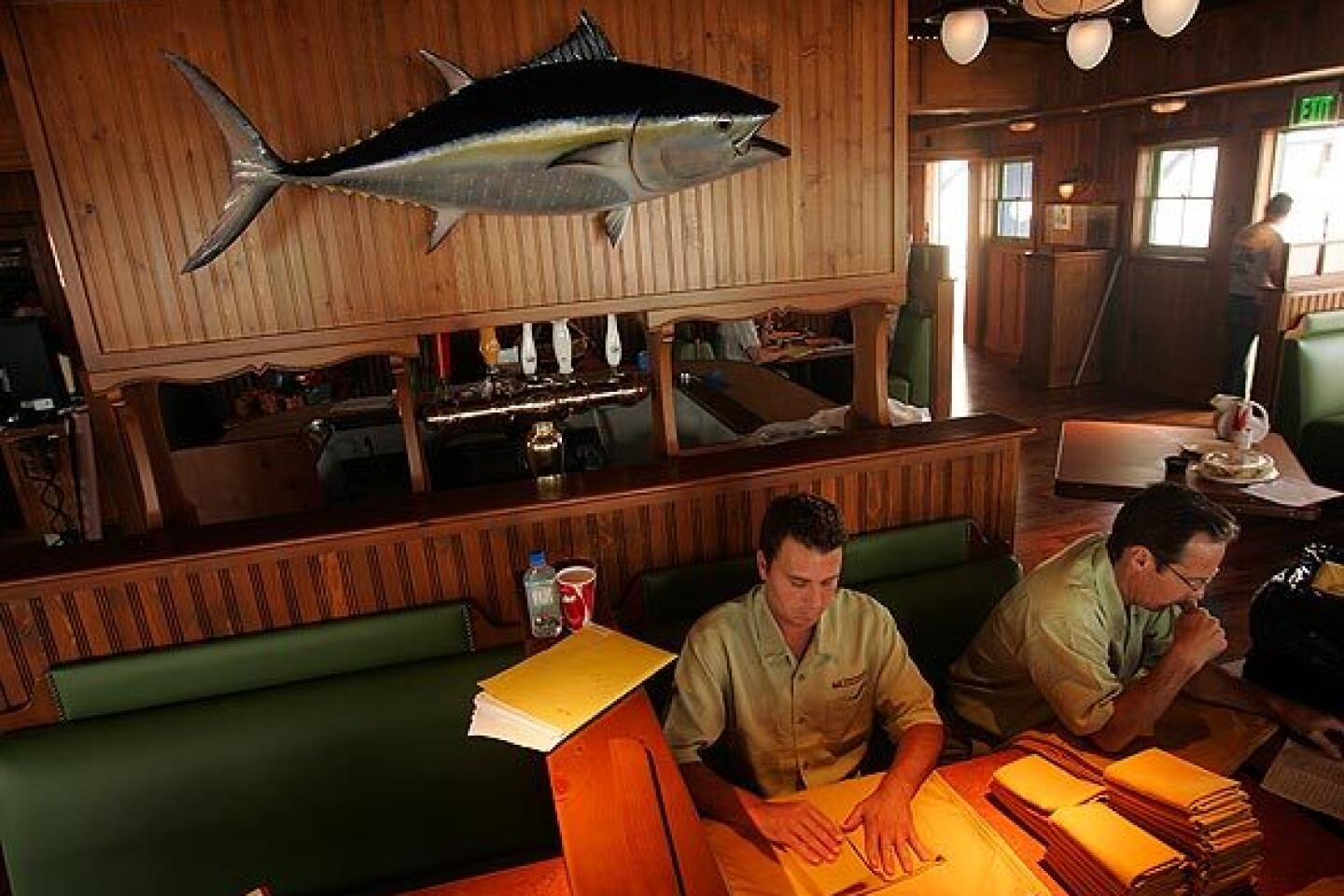Reopening marks new chapter in Malibu Pier’s history book
- Share via
After years of false starts and construction delays, the fabled Malibu Pier -- or at least part of it -- will reopen today.
Built in 1905, the structure has been the scene of TV and movie filming (“The Rockford Files,” “Gidget,” “Beach Blanket Bingo”) and celebrity sportfishing. It was used as a World War II lookout post. Later, Alice’s Restaurant (inspired by the Arlo Guthrie song) served its famous B-52 cocktail to droves of visitors.
But a series of severe winter storms so damaged the pier that it was closed to the public in 1995. In recent years, it has seen limited use by fishermen and other visitors who craved some full-scale amenities to go with the million-dollar view.
This evening, a gala fundraiser will mark the official unveiling of a bar and restaurant at the Pacific Coast Highway entrance to the refurbished structure.
Visitors venturing onto the weathered boards will see two wood-sided white buildings with royal blue trim. One is the Beachcomber Cafe (formerly Alice’s), a bar and restaurant featuring seafood and a mid-1940s atmosphere. Across from that is the Malibu Pier Club, which for several weeks has been serving cocktails and lighter fare from a small indoor bar and an outdoor deck.
A TV over the bar shows a loop of home movies shot at the pier during its heyday years ago. Photos of bathing beauties and buff beachgoers from decades past line the walls.
At the seaward end of the pier, construction delays have forced the Ruby Restaurant Group of Newport Beach to push back the opening of a burger joint, now expected to open in August. A bait-and-tackle shop, coastal boat tours and a surf museum are also planned. Two sportfishing boats already operate from the pier.
Setbacks have occurred with frustrating frequency during the revival of the coastal landmark. The multiyear restoration effort spawned a series of legal tiffs -- between the state (which owns the property) and its concessionaire, between the concession partners, and between the concessionaire and a restaurant company that didn’t make the cut. Some of those spats are still being resolved in and out of court.
Built at the southern end of Malibu Lagoon State Beach, the pier through the years was bashed by winter storms that uprooted pilings and forced costly repairs. The state Department of Parks and Recreation closed the structure 13 years ago after damage made it unsafe even for strolling. Since then, the agency has been eager to make repairs to get the place up and running and revenue flowing again.
“Piers are expensive,” said Ron Schafer, district superintendent for the Angeles District of the parks agency. “They’re like boats.”
Malibu’s pier stands as an interesting contrast to the Santa Monica Pier, which with its Ferris wheel, historic carousel building and eateries attracts more than 4 million visitors a year. In the 1970s, when the city of Santa Monica threatened to tear down the pier for a redevelopment project, citizens rallied to save it. In 1985, the city established a pier restoration entity to manage and oversee the structure. Since the mid-1980s, “the city has easily invested well over $60 million,” said Ben Franz-Knight, executive director of the Santa Monica Pier Restoration Corp. The private sector has invested an almost equal amount, he said.
In Malibu, the pier restoration and construction costs came to about $10 million, according to Jefferson Wagner, owner of the nearby Zuma Jay surf shop and one of the concession partners who in April won election to the Malibu City Council.
The pier’s history is entwined with that of an influential Malibu family. Businessman Frederick Rindge and his wife, May, commissioned the structure as a shipping wharf for hides and grains from their 17,000-acre Malibu Rancho. It served as a dock for unloading materials to build the family’s private 20-mile railroad.
During Hollywood’s golden age in the 1920s and ‘30s, film studios shot sea epics at the pier. It later was a backdrop for many a 1960s beach blanket flick with Frankie Avalon and Annette Funicello.
The pier opened to the public in 1934. Big stars including Buster Crabbe and Cesar Romero were among those who fished for halibut and barracuda from a barge anchored offshore. After the Rindges’ land-development venture, Marblehead Land Co., went broke in 1936, bondholders took over the pier and extended it to its current 780-foot length.
During World War II, the pier served as a U.S. Coast Guard lookout until a storm in the winter of 1943-44 demolished much of the structure. Businessman William Huber then bought it for $50,000 and rebuilt it. After the war, he constructed the twin buildings at the seaward end for a bait-and-tackle shop and restaurant.
In 1980, the state purchased the property.
A 1983 El Niño storm destroyed many of the pilings, and parks officials closed the pier for 18 months. Soon after it reopened, the state named it a historic point of interest. Big storms in 1993 and 1994 further damaged the pier, and parks officials shuttered it in 1995.
Tony Wootton, 63, a tourist from near Kenilworth, England, said he and a companion had passed the pier many times on their vacation and finally stopped for a stroll on the well-worn boards. He pronounced it “a very English pier, like Brighton, maybe.”
Malibu Mayor Pamela Conley Ulich said the community was looking forward to the “grand reopening.”
“It’s kind of like the archway into Malibu,” she said. “At least now when people see the pier, they’ll know they’re in Malibu.”
More to Read
Sign up for Essential California
The most important California stories and recommendations in your inbox every morning.
You may occasionally receive promotional content from the Los Angeles Times.

















